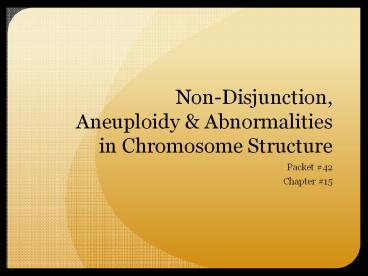Non-Disjunction, Aneuploidy - PowerPoint PPT Presentation
Title:
Non-Disjunction, Aneuploidy
Description:
Non-Disjunction, Aneuploidy & Abnormalities in Chromosome Structure Packet #42 Chapter #15 * * * * * * * * * * * * * * * * * * * * * * * * * * * * Introduction I ... – PowerPoint PPT presentation
Number of Views:631
Avg rating:3.0/5.0
Title: Non-Disjunction, Aneuploidy
1
Non-Disjunction, Aneuploidy Abnormalities in
Chromosome Structure
- Packet 42
- Chapter 15
2
Introduction I
- Ploidy
- Degree of repetition of the basic number of
chromosomes - Diploidy
- Chromosomes repeat 2X
- Remember, in humans, you have one copy of a
chromosome from the maternal father and one from
the maternal mother - Euploidy
- True ploidy
- In the case of somatic human cells, euploidy
occurs when the cell is diploid.
3
Aneuploidy
- Not True ploidy
- Having too many or too few chromosomes.
- Non-Disjunction
- An event that occurs occasionally during meiosis
in which a pair of chromosomes fail to separate
so that the resulting germ (sex) cell has either
too many or too few chromosomes
4
Genetic Disorders Caused by Aneuploidy
- Sex Chromosome Aneuploidy
5
Turner Syndrome
- 2n - 1
- 45 XO
- 44 autosomes 1 X chromosome
- There is the absence of a sex chromosome
- Female in appearance but their female sex organs
do not develop at puberty and they are sterile - Short in stature
- Shows normal intelligence but some cognitive
functions are defective - 1 in 5000 female births show Turner Syndrome
6
Turner Syndrome II
7
Klinefelter Syndrome
- 2n 1
- 47 XXY
- 44 autosomes 3 sex chromosomes
- There is an extra X chromosome
- Male in appearance and they too are sterile
- Female type pubic hair pattern
- May have breast development
8
Klinefelter Syndrome II
9
Comparison of Turner Klinefelter Syndromes
10
XYY vs. XXX
- XXY
- XXX
- Males that are usually fertile
- Predisposition to be more violent in behavior
- Gametes never YY or XY--meiosis is normal
- After age of 35, extra Y chromosome often
degenerates and is not passed onto offspring
- Fertile females
- May be some mental disabilities
- Eggs will produce only X after meiosis--not XX
11
Genetic Disorders Caused by Aneuploidy
- Autosomal Aneuploidy
12
Down SyndromeTrisomy 21
- Caused by an extra copy of chromosome 21
- There are three copies of chromosome 21 in their
somatic cells - 0.15 percent of all live births
- Growth failure and mental retardation
- Big toes widely spaced
- Congenital heart disease
- Mean life expectancy is about 17 years and only 8
survive past age 40
13
Patau SyndromeTrisomy 13
- Multiple defects
- Death is typical by the age of 3
14
Edwards SyndroneTrisomy 18
- Ear deformities
- Heart defects
- Spasticity and other damage
- Death is typical by the age of 1
- Some may survive longer
15
Abnormalities in Chromosome Structure
16
Introduction I
- The changes in the shape of the chromosome may be
due to either of the following - Translocation
- Deletions
- Fragile sites
17
Abnormalities in Chromosome Structure
- Translocation
18
Translocation
- A chromosome fragment breaking off and attaching
to a non-homologous chromosome - Reciporcal translocation
- Two non-homologous pairs exchange genetic
information - Can result in deletion and/or duplication of genes
19
Translocation Down Syndrome
- 4 of Down Syndrome cases
- Individuals actually have 46 chromosomes
- One of copies of chromosome 14 has combined with
chromosome 21 - The large arm of chromosome 21 has been
translocated to the large arm of another
chromosome--usually chromosome 14
20
Abnormalities in Chromosome Structure
- Deletion
21
Deletion
- The loss of part of a chromosome
- The abnormal chromosome is known as a deletion
- Sometimes chromosomes break and fail to rejoin
22
Cri du Chat Syndrome
- Part of the short arm of chromosome 5 is deleted
- Breakage point varies from case to case
- Infants normally have a small head with altered
features - Moon face
- Infants have a distinctive cry that sounds like a
cat mewing - Infants normally survive childhood
- Exhibit severe mental retardation
23
Abnormalities in Chromosome Structure
- Fragile Sites
24
Fragile Sites
- Weak points at specific locations in chromatids
- Appears to be a place where part of a chromatid
appears to be attached to the rest of the
chromosome by a thin thread of DNA - Have been identified on the X chromosome and
certain autosomes
25
Fragile X Syndrome
- Fragile site occurs near the tip of the X
chromosome - Where nucleotide triplet CGG is repeated many
more times than normal - Most common cause of mental retardation
26
Genetic Screening Pedigrees
27
Genetic Screening Genetic Counseling
- Genetic Screening
- Identifies individuals who might carry a serious
genetic disease - Screening of newborns is the first step in
preventative medicine - Genetic Counseling
- Provide couples, concerned about the risk of
abnormality in their children, medical and
genetic information
28
Pedigrees
- Definition
- A family tree that shows the transmission of
genetic traits within a family over several
generations. - Pedigree Analysis
- Useful in detecting autosomal dominant mutations,
autosomal recessive mutations, X linked recessive
mutations and defects due to genomic imprinting - Genomic Imprinting
- Expressions of a gene based on its parental origin
29
Pedigree Analysis
30
Pedigree Analysis
31
Homework
- Bioinformatics
- Proteomics
- Aminocentesis
- Chronic villus sampling (CVS)
- Preimplantation genetic diagnosis (PGD)
- Know how to discuss (argue for/against)
- Genetic discrimination
- The Human Genome Project































